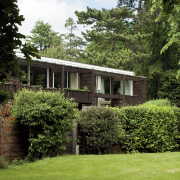Architect
Atelier 5
Developer
Wates Ltd
Contractor
Wates Ltd
Planning Authority
Croydon Borough Council
Click any image for a larger view
By the late 1960s, canny housebuilders were beginning to realise that the buyers Eric Lyons had cultivated with Span Developments (Awards 1961 to 1985) were no longer just an inconsequential niche market. Neil Wates, with the freedom given him by a large family firm, a clear understanding of current architectural thinking, and a questioning approach to received market wisdom, decided to take a trip to Berne, to see the Halen development by the young architectural team Atelier 5.
A commission followed. The Berne scheme involved three terraces of court houses stepping down the hillside, with an entrance court on the upper level, and another court at the lower level. Croydon is scarcely Switzerland, but the site Wates had in mind had a large enough fall to allow the upper floors a sight of, if not the Alps, at least the Surrey foothills.
So the living areas are on the upper floor, with the bedrooms below. Both the upper (entrance/dining) court and the lower garden court have access to pedestrian walkways, but are completely secure from overlooking. And, as at Halen, the car parking is tucked underneath at the top end of the site. This was indeed a radical departure from the English suburban norm.
But it was not alone. Two years later, Phippen Randall Parkes won an Award for an equivalent scheme at Forestfield, Crawley. Both developments addressed the question, generally debated at the time, of how to reconcile the necessary compactness to achieve a real community with the issue of privacy; but St. Bernard’s has undoubtedly the more gripping impact, with its lush planting, Arcadian timber detailing, and views over a splendid semi-private communal landscape (the public can walk through – a neat compromise).
All 21 houses in the first phase were snapped up almost immediately.“Time to press the button, Wates”, cried the Architectural Review, calling for the second, much larger phase to be put in hand, “and collect a well-earned accolade for one of Britain’s outstanding post-war developments”. But the miners’ strike and then the Arab/Israeli war intervened, and we are left with a beautiful, tantalising fragment.




